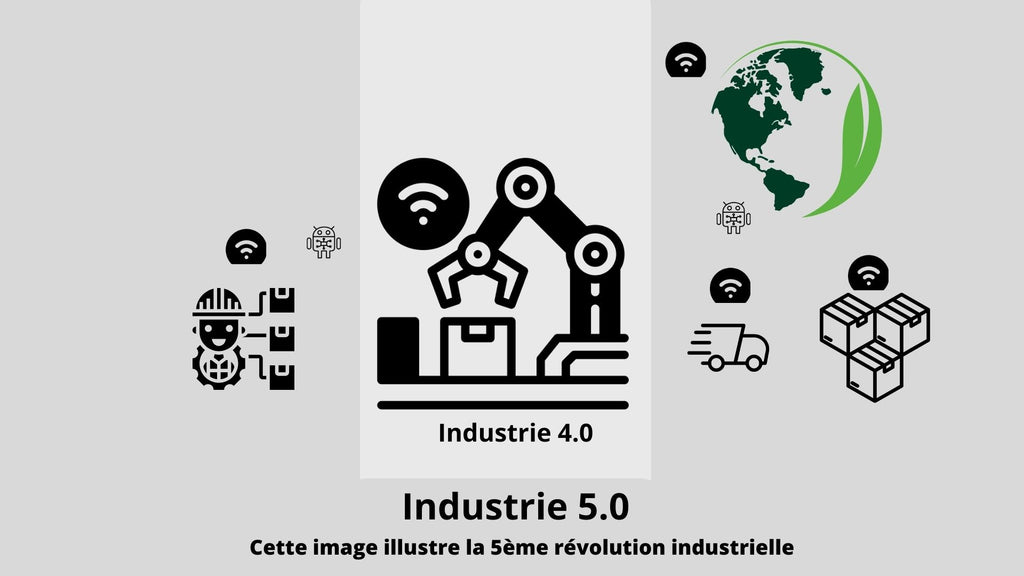
The Industry of the Future: Artificial Intelligence and Latest Technologies
Introduction
For generations, industry has been the pillar of progress, which has transformed our economies, our way of living and working. Today, in the digital age, the industry is on the cusp of a major new transformation. The rise of artificial intelligence (AI) and innovative technologies is propelling the industrial world towards new horizons. This mutation, although complex, opens the door to a multitude of possibilities unimaginable just a few decades ago.
Historical Context of Industrial Transformation
The first industrial revolution (end of the 18th century): Powered by the steam engine, this period saw the birth of mechanization and marked the transition from artisanal production to mass production. Factories have become the new economic centers, replacing artisanal workshops.
The second industrial revolution (late 19th century - early 20th century): Electrification and the birth of mass production, notably through the adoption of the assembly line, gave birth to this era. Technological innovation has accelerated, disrupting both commerce and daily life.
The Third Industrial Revolution (1970s - 2000s): Also known as the digital age, this period was characterized by the adoption of computing, information technology and the Internet in industrial processes . Automation has been introduced on a large scale, fundamentally changing the nature of work.
Entering the 21st century, the industry is facing a new wave of transformation, often referred to as the fourth industrial revolution or “ Industry 4.0 ”. It promises to interconnect and optimize every facet of production through technologies like AI, big data, and the Internet of Things (IoT).
In 2022, the advent of artificial intelligence has prompted industries to plan a radical transformation of their processes, moving from intelligent production systems to fully autonomous production and supply systems and new concepts of Industry 5.0 begins to take concrete form.
Adopting the latest technologies is essential to remaining competitive in an increasingly connected and globalized market.
Artificial Intelligence (AI): A Driving Force for the Industry of the Future
Artificial intelligence , once relegated to the realms of science fiction, is today a reality shaping every aspect of our world. In the industrial sector, it is starting to arouse the interest of decision-makers, who are increasingly aware of the importance of integrating AI into their operations.
-
Definition of AI: AI encompasses a set of techniques and algorithms that enable machines to imitate and perform tasks that traditionally require human intelligence, such as pattern recognition, decision-making, and solving complex problems.
-
Applications of AI in industry: With its analysis and prediction capabilities, AI is used to optimize the production line , predict machine maintenance , improve logistics and even personalize products in real time to meet customer needs.
-
AI and Automation: AI also helps increase automation by making machines more autonomous. This autonomy makes it possible to reduce costs , increase efficiency and quickly adapt to market developments.
As the industry prepares to fully integrate AI, it stands at a crossroads, ready to shape the future with smarter, faster and more efficient solutions.
The Latest Technologies Accelerating Industrial Transformation
While artificial intelligence plays a leading role in the current industrial revolution, it is not the only technology pushing the boundaries of what we thought possible. Several emerging technological innovations complement and enhance the capabilities of AI, propelling the industry toward unprecedented efficiency and adaptability.
-
Internet of Things (IoT): Connected devices are ubiquitous, collecting and transmitting data in real time. In industry, IoT enables constant monitoring of the production line, providing valuable insights to optimize operations.
-
Blockchain: Often associated with cryptocurrencies, blockchain finds its place in the industrial supply chain by guaranteeing the traceability, transparency and security of transactions.
-
Augmented and virtual reality (AR/VR): AR/VR are increasingly used for training, maintenance, and design. They make it possible to visualize industrial processes and interact with them in a new way.
-
Advanced robotics: Robots , now capable of learning and adapting their actions thanks to AI, have become essential collaborators, performing repetitive or dangerous tasks with unparalleled precision and efficiency.
The Challenges and Opportunities of Technological Integration
Although these technologies promise to reshape the face of the industry, their integration is not without challenges. Yet by recognizing and addressing these obstacles, the industry can also uncover new opportunities.
-
Security: With the increase in connected devices and dependence on technology, security threats are increasing. Protecting industrial systems against cyberattacks has become a priority.
-
Training and skills: As machines and software take over some tasks, employees must be trained to master these new technologies and work in harmony with them.
-
Ethics and regulation: With the adoption of AI, questions of ethics and regulation emerge, particularly regarding liability in the event of errors or accidents.
-
Opportunities for innovation: Paradoxically, every challenge presents an opportunity. The need to secure systems can lead to innovation in cybersecurity. The demand for training can stimulate the development of innovative educational programs. And ethical issues can prompt the creation of universal industry standards .
By embracing both challenges and opportunities, the industry is able to successfully navigate this new era of technological transformation, while setting the stage for an even brighter future.
Perspectives and Challenges of Industrial Digitalization
With the rise of disruptive technologies, the industry is faced with a dual reality: on the one hand, the urgency of adopting these innovations to remain competitive, and on the other hand, the need to understand and anticipate the issues they pose.
-
Adaptability: In a constantly changing environment, agility and the ability to adapt have become essential. This goes well beyond the simple integration of new technologies; it’s a complete overhaul of how businesses operate and respond to change.
-
Social and Environmental Responsibility: The adoption of cleaner and more efficient technologies paves the way for more environmentally friendly production. Additionally, with increasing automation, how can we ensure fair and sustainable jobs for the workforce?
-
Interconnectivity: As systems become more integrated, the ability to collaborate and exchange information seamlessly with partners, suppliers and customers is crucial.
To delve deeper into these issues and discover how leading industries are tackling these challenges, consult our White Paper on the Industry of the Future.
Towards a Renovated Industrial Model: The Keys to the Future
As the industrial landscape continues to evolve, certain key trends and principles stand out, pointing the way toward an industrial model of the future.
-
Humans at the Heart of Technology: Despite increasing automation, the importance of the human element remains central. Technology must be at the service of humans, improving the quality of life, facilitating work and stimulating creativity.
-
Cross-Sector Collaboration: Boundaries between industries are becoming more porous, with unprecedented collaborations between once-distinct sectors. This opens the way to innovations and transversal solutions.
-
Circular Economy: Beyond simple production, it involves considering the complete life cycle of products, from design to end of life, integrating the principles of sustainability and recyclability.
-
On-Demand Customization: With technologies such as 3D printing, the industry is increasingly able to meet specific needs and produce on demand, thereby reducing waste and maximizing customer value.
Understanding these key trends and anticipating their implications is essential for any business wishing to not only survive but thrive in the industry of the future.
The Culture of Innovation: Key to Industrial Transformation
While technology plays an undeniable role in industry transformation, it is the culture of innovation that is often the real driver of change. This culture is based on a constant desire to question, experiment and seek new ways of doing things. It encourages calculated risk-taking, interdisciplinary collaboration and the promotion of ideas from all levels of the company. More than just a set of practices, innovation culture requires a mindset – a commitment to curiosity, continuous learning and adaptability. In the context of the industry of the future, where the only constant is change, cultivating this culture of innovation is not only desirable, but essential to ensure sustainability and long-term success.




